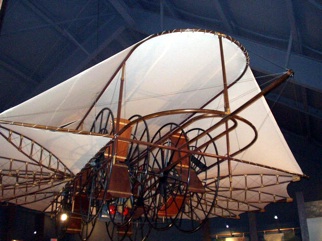
"The appearance of the wheels . . . and their work was as . . . a wheel in the middle of a wheel."(Ezekiel 1:16) "And when the living creatures went, the wheels went by them; and when the living creatures were lifted up from the earth, the wheels were lifted up.". . . (Ezekiel 1:19)
His airship featured fabric-covered wings powered by an engine that turned a series of wheels and paddles. In late 1902, the plane was flown about 160 feet but stopped before it drifted toward a fence. In 1904, seeking to exhibit the craft, Cannon loaded his airship onto a railroad flatcar and started to St. Louis for the World's Fair. But a storm blew it from the flatbed railcar near Texarkana, destroying the machine. Cannon built a second airship around 1911 but it was also destroyed when a hired pilot flew it into the top of a telephone pole during a test flight. The incident caused Cannon to give up on his flying machine.
Upon reading about the Ezekiel Airship I was inspired to compose a musical work that might give homage to Cannon's invention. As the composition unfolds, I attempt to depict his "vision" of flight; the successes and failures of his experiments; as well as the final ironies of using an older form of transport (land-based railcar) to introduce a new one (air-based plane) and that "wind" is a force that is both enabling (controlled levitation) or disabling (uncontrolled atmospheric disturbance).
Conceptually, Cannon's idea of "wheels-within-wheels" recurs throughout the composition in my approach to the music: the initial motive provides all the generative, propulsive and (re)cyclic material for the entire work. I simply "altered" the materials using pitch and time compression or expansion, inversion, transposition, sequencing, amalgamation, truncation, etc.—in other words, devices in the "Composer's toolbox."